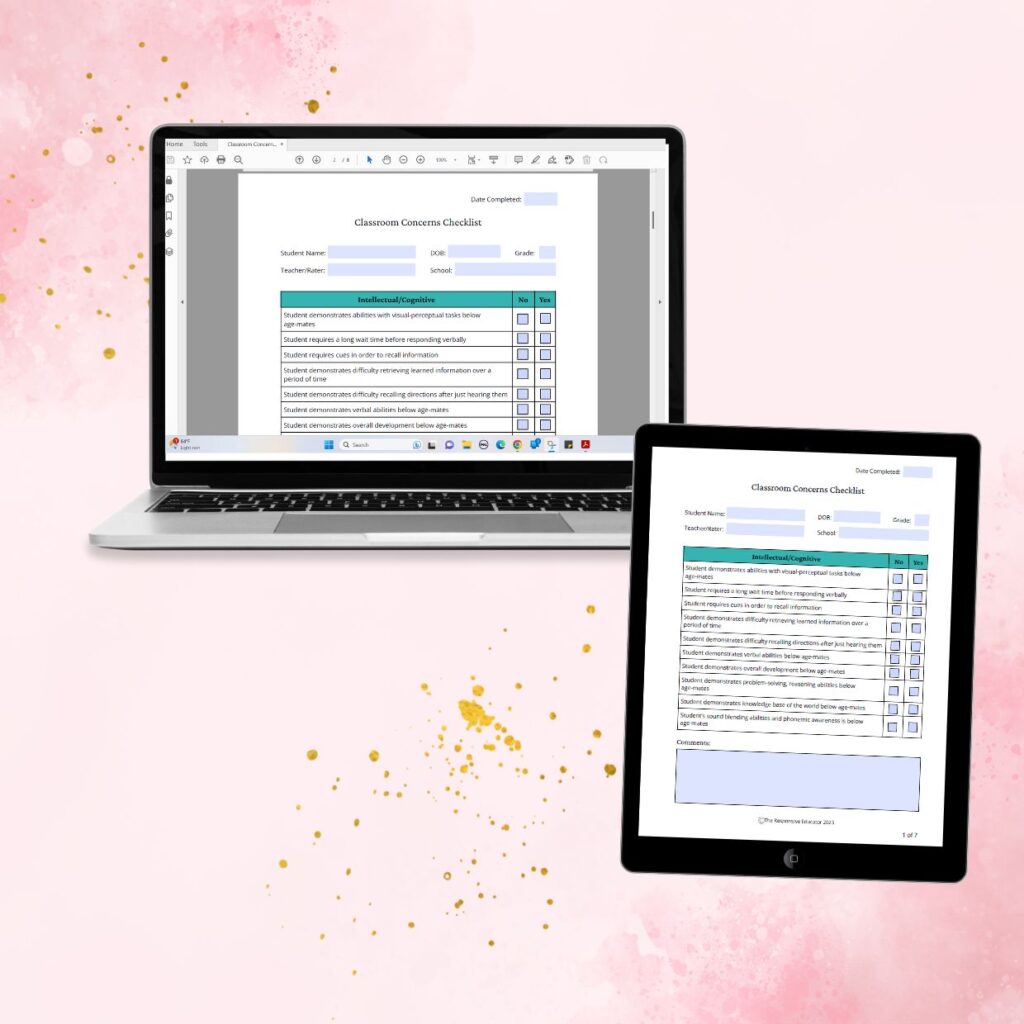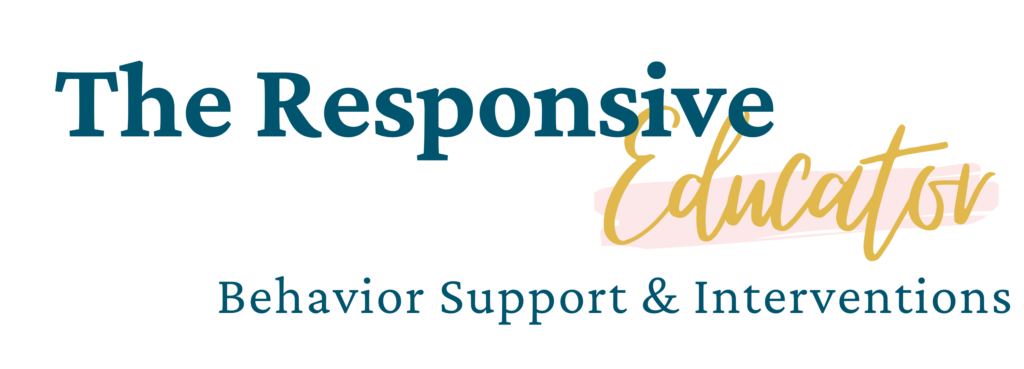
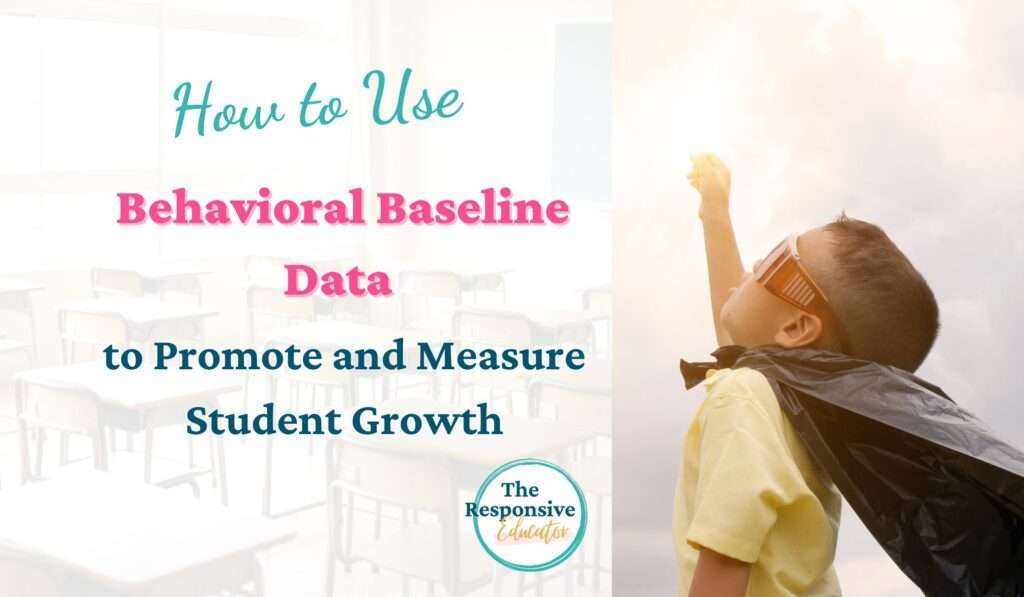
In education, baseline data is an essential tool that teachers and educators use to evaluate the progress of their students. Usually, baseline data is used to monitor academic growth and improvement through pretests and post-tests. By doing so, teachers can get a starting point to assess their students’ knowledge and adjust their teaching methods to suit individual student needs.
But did you know that baseline data is equally critical in behavior management? Allow me to share a personal experience that highlights the importance of accurate and meaningful behavioral baseline data.

During my time working at an alternative school focused on improving student behavior, I encountered a significant challenge. The school’s intention was to gather data on the specific behaviors that led students there and to track the progress of those behaviors over time. The goal was to help students reintegrate into their neighborhood schools once their behaviors had improved
However, I quickly realized that instead of tracking the specific behaviors, we were measuring something entirely different. The school was relying on counts of “maladaptives” and “referrals,” which were write-ups given by teachers for any behavior they deemed inappropriate. The problem was that there was no consistency or clear guidance regarding which behaviors should be categorized as maladaptives or referrals.

This flawed approach resulted in us unintentionally measuring the adults’ tendency to write students up rather than accurately capturing the students’ actual behavior. The data we had was inconsistent and mostly useless for determining student progress on the specific behaviors that had led them to the school in the first place. It became evident that without accurate and reliable baseline data, we couldn’t effectively fulfill the state’s requirement of measuring student growth on those specific behaviors.
This experience highlighted the significance of establishing a reliable behavior-tracking system and obtaining real behavioral baseline data. It inspired me to revamp the behavior-tracking process at the school and implement a more comprehensive and systematic approach to data collection. By doing so, we were able to gather valuable insights into student behaviors, identify patterns and triggers (both part of the functional behavior assessment process), and develop targeted interventions to support their growth.
In this post, we’ll delve into what behavior baseline data is, how to collect it effectively, and most importantly, how to use it to support student success. We’ll discuss why behavior baseline data is crucial, how it can be used to develop effective interventions, and how it helps measure student growth and progress. Armed with a solid understanding of behavior baseline data, educators can create a supportive and effective learning environment that meets the needs of all students.
Note: I am an Amazon Affiliate. If you purchase products through the links provided, I will earn a small commission at no extra cost to you, which helps support the blog.
Target behaviors are specific behaviors of concern that the FBA (functional behavior assessment) team wants to understand and change, in order to improve the student’s functioning and well-being.
Identifying target behaviors typically involves a thorough review of the student’s behavior history, as well as interviews with parents, teachers, and other relevant stakeholders. Once identified, target behaviors are defined in clear and measurable terms.
For example, a target behavior might be “aggressive behavior towards peers during recess,” or “refusing to follow teacher directions during independent work time.” Once the target behavior has been identified and operationally defined, the FBA team can begin to gather behavioral baseline data to better understand the circumstances surrounding the behavior, and to develop interventions to address it.
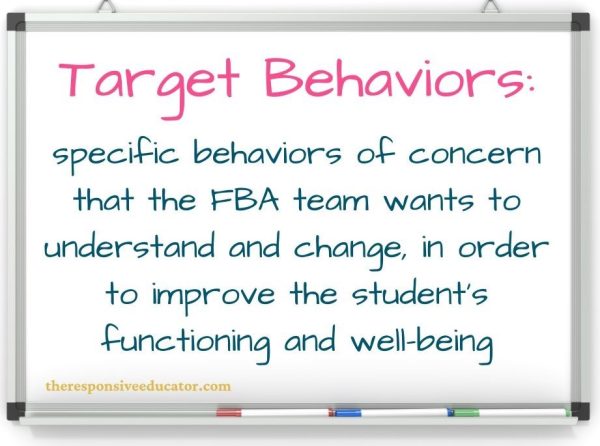
When analyzing behavioral baseline data and prioritizing which behaviors to target for intervention, it’s important to consider safety concerns and the level of disruption they cause in the classroom.
It’s generally recommended to work on no more than 2-3 behaviors at a time to avoid overwhelming the team and to make progress in behavior change.
Safety concerns should always be addressed first, and any behavior that poses a risk to the student or others needs immediate attention. Once safety concerns have been addressed, focus on the most disruptive behaviors that interfere with learning or create a negative environment in the classroom.
By being strategic and prioritizing a limited number of target behaviors, the team can maximize their efforts and make the most progress in behavior change, ultimately creating a positive learning environment for students.
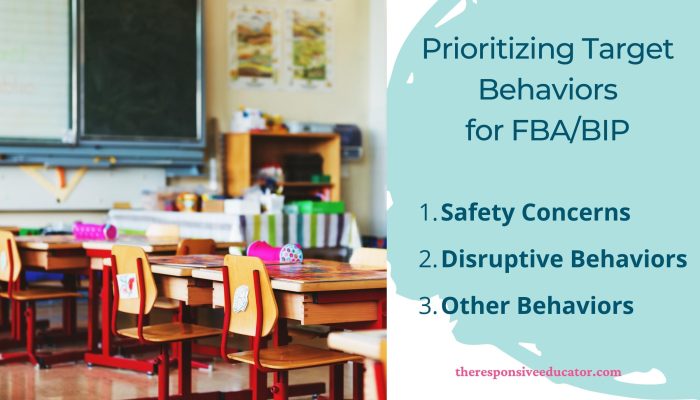
After selecting the behaviors to focus on based on the behavioral baseline data, it’s important to establish operational definitions for them. Operational definitions are specific and measurable descriptions of the behavior, which help ensure accurate and consistent data collection.
To operationally define a behavior, you want to start by breaking it down into specific, observable actions or events that can be measured or recorded. This involves identifying the key components of the behavior and outlining the conditions under which it occurs. Operationally defining behavior targets is very important, but might take a little practice.
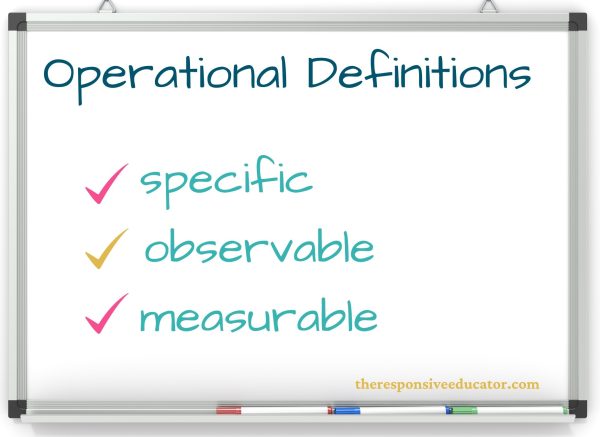
For instance, let’s say you want to operationally define the behavior of “raising your hand in class.” You might break this behavior down into the following observable actions:
In addition to identifying the specific actions associated with the behavior, you also want to define the conditions under which the behavior is expected to occur. For example, the behavior of “raising your hand in class” might be defined as occurring during whole-class discussions, when students are expected to ask questions or contribute to the conversation.
Overall, operational definitions provide a clear and objective way of identifying and measuring behaviors, which is essential in research and data collection. By breaking down behaviors into specific, observable actions and conditions, researchers and educators can accurately measure and track behaviors over time, identify trends and patterns, and develop effective interventions to support positive behavior change.
Defining the behavior in this specific and observable way helps establish clear criteria for what counts as the target behavior. It also ensures that the data collected is accurate, reliable, and consistent across different observers. With a clear operational definition, educators can identify patterns and trends in the student’s behavior, determine the most appropriate interventions to use, and evaluate the effectiveness of those interventions.
Once operational definitions are established, the next step is to gather quantitative behavioral baseline data, which is crucial in identifying a clear pattern of the problematic behavior before any interventions are implemented. Essentially, baseline data refers to the behavior patterns of the student prior to any intervention or treatment.
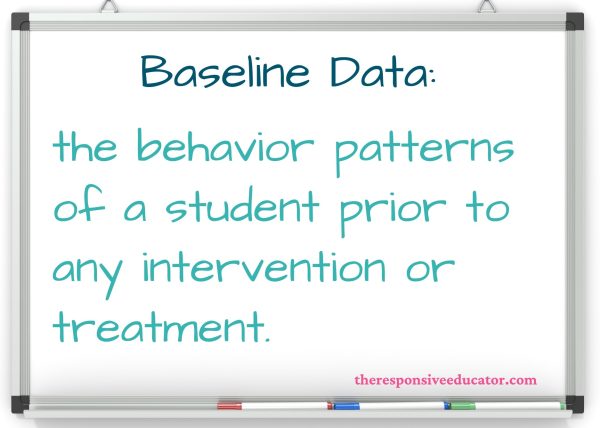
For instance, if a student exhibits disruptive behavior in class, collecting behavioral baseline data can help determine the frequency, duration, and intensity of the behavior. This information can aid educators and behavior specialists in creating an intervention plan that specifically targets problematic behaviors.
To ensure the behavioral baseline data’s accuracy and reliability, it’s recommended to collect data for at least three weeks, or longer if possible, and consistently at regular intervals, such as during certain times of day or in specific settings.
Collecting behavioral baseline data over an extended period helps distinguish between isolated incidents and recurring behavior patterns, providing insights into developing an effective intervention plan tailored to the student’s specific needs.
Remember, the aim of collecting behavior baseline data is to solve problems, not just to identify them. The objective is not to use data to highlight how “bad” a student’s behavior is, but to establish a starting point before implementing interventions.
Behavior baseline data can be a useful tool for setting realistic goals for students. By graphing a student’s behavior patterns over a period of time, educators and behavior specialists can identify the frequency, intensity, and duration of problematic behavior. This information can help set realistic goals for the student and the team, taking into account the student’s current abilities and the complexity of the behavior.
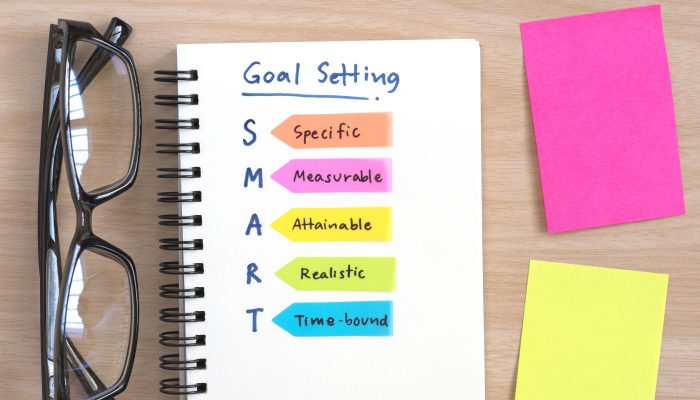
For example, if a student exhibits disruptive behavior in class for an average of 10 minutes per hour, a realistic goal may be to reduce the behavior to five minutes per hour within a specific timeframe.
It is important to note that behavioral interventions are not a quick fix, and it may be unrealistic to expect problem behavior to immediately disappear. Instead, it is important to focus on incremental improvement and celebrate small victories along the way.
By setting realistic goals and tracking progress over time, educators and behavior specialists can help students make meaningful progress toward behavioral change. This can lead to increased confidence and self-esteem for the student, and ultimately, greater success in school and in life.
Graphing behavioral baseline data involves plotting a student’s behavior patterns over time before any interventions are introduced. This results in a graph that shows the frequency, intensity, and duration of the targeted behavior, which can help identify triggers and antecedents.

For example, a graph may show that a student exhibits disruptive behavior more frequently during certain times of day or in specific settings. This information can help educators and behavior specialists identify potential triggers and antecedents for the behavior, which can inform intervention planning.
Educators and behavior specialists can use this tool to understand behavior patterns and determine the best course of action to address problematic behavior. Analyzing the graph can provide insights into the behavior and potential triggers, leading to informed decisions when deciding on interventions.
Behavior interventions are a critical tool for addressing problematic behaviors in students, but they must be monitored and evaluated over an extended period of at least three weeks. This is because interventions are not a one-time solution, but rather a process that requires ongoing data collection and analysis.

For example, a student may have a history of disruptive behavior in class. To address this behavior, a behavior specialist may implement an intervention plan that includes positive reinforcement for good behavior and a token economy system for negative behavior.
The behavior specialist would collect behavioral baseline data on the frequency and intensity of the disruptive behavior and compare it to data collected after the intervention is introduced.
By comparing the intervention data to the baseline data, educators and behavior specialists can determine whether the intervention is effective in reducing problematic behaviors. If progress is being made, the intervention should continue. If progress is not being made, it may be necessary to try a new intervention.
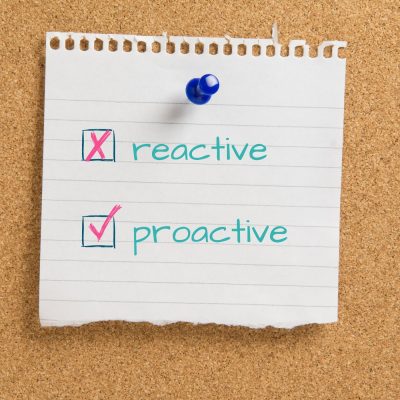
For example, if the data shows that the target disruptive behavior has decreased by 50% after implementing the intervention, it may be a sign that the intervention is effective and should continue.
However, if the data shows that the disruptive behavior has not decreased at all, it may be necessary to try a different intervention that better addresses the specific behavior. Look here to see an example of a behavior graph with baseline and intervention data.
By taking a proactive (rather than reactive) and data-driven approach to behavior interventions, educators and behavior specialists can help students make meaningful progress toward their behavioral goals.
Ongoing data collection and analysis allow for informed decisions about adjusting interventions and modifying them to better address the student’s needs. This ensures that interventions meet their goals and that students make progress, while also providing insights for improving behavior management strategies in the future.
Another benefit to quantitative data is that it can help us take the emotion out of problem behavior. When dealing with a student with problem behavior, it can sometimes feel like correcting this particular child for this particular behavior takes up most of our day. We may think of the behavior as happening “all day,” “all the time,” or “constantly.” This type of thinking, however, doesn’t help us when it comes to making behavior change. In fact, it can have the opposite effect by making the behavior so big in our minds that solving it seems insurmountable.

Telling ourselves that a behavior happens “constantly” can color how we see the child, stopping us from seeing potential or progress. We start to be hyper aware of everything this child does wrong (while perhaps not even noticing a similar behavior from a peer). We begin to mentally shoot down any potential intervention, having already convinced ourselves that nothing will work, they will never change, and trying interventions is just a waste of time.
Children are more than their worst behaviors, and many behavior problems that seem unsolvable feel that way because we just haven’t found the right tool yet. If we really want to improve the behavior, and give the student the best shot, it is important to find a way to take our frustrations and emotions out of the equation.Taking baseline data helps us to take the emotion out of problem behavior by allowing us to have a clear picture of what is happening over the course of a day.
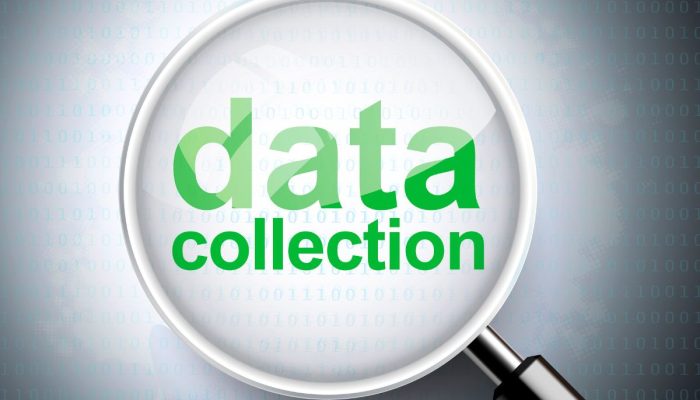
Behavior baseline data collection methods should be carefully selected based on the type of behavior being observed and the specific goals of the data collection. The method used to collect data will depend on the behavior’s frequency, duration, intensity, and the context in which it occurs. There are several methods of collecting data, including frequency count, interval recording, and duration recording, each appropriate for different types of behaviors. Below is a brief explanation of some of the most commonly used behavior data collection methods.
Frequency count is a useful method for behaviors that happen repeatedly for a short duration, such as calling out in class. This method involves counting the number of times the behavior occurs during a specific time frame, such as every 10 minutes during a class period, and recording the data.
Interval recording, on the other hand, is more effective for behaviors that occur less frequently but have a longer duration, such as tantrums or aggression. This method involves dividing the observation period into smaller intervals, such as every 5 minutes, and recording whether the behavior occurred or not during each interval.
Duration recording is useful for tracking how long a behavior lasts, such as a student’s time spent off-task during class. Once data is collected, it can be graphed to provide a visual representation of the behavior over time, making it easier to analyze and identify patterns.
Another method of behavioral data collection is using rate. Rate measures how often a behavior occurs within a given time period, such as the number of times a student calls out in class per minute. This method is useful when the behavior happens frequently and quickly. Rate can also be used to measure the reduction of behavior over time, as the goal of an intervention is often to decrease the frequency of a behavior. By measuring the rate of the behavior, educators and behavior specialists can identify whether an intervention is effective in reducing the behavior.
Ultimately, the choice of data collection method should be based on the specific behavior being observed and the goal of the data collection. By selecting an appropriate method and graphing the data collected, educators and behavior specialists can gain a clearer understanding of the behavior and make informed decisions about the most effective interventions to use.

As you begin the process of collecting behavior data, it’s important to examine your mindset and intentions. If you approach behavior data collection with the mindset of just “jumping through hoops” or if you have a belief that a student will never change, it’s unlikely that you’ll see any significant improvement. It is important to, instead, keep an open mind.
Remember that many problem behaviors students exhibit are learned behaviors. Learned behaviors are those that an organism (in this case, a student) has developed as a result of experience. For example, if a student regularly engages in disruptive behavior in class, it’s likely that they’ve learned to behave in that way because it has been effective for them in some way in the past. In other words, they have learned that this behavior gets them something or gets them out of something with decent reliability.
However, the good news is that learned behavior can be unlearned. For instance, if a student has learned that throwing a tantrum results in getting something they want or getting out of something they don’t want, they will continue to use that strategy until it no longer works. So, by identifying the learned behavior, we can develop interventions to make sure that the inappropriate behavior no longer works for them in the same way. In this way, we can help students unlearn problem behaviors and replace them with more appropriate ones.
We must remember that merely collecting behavior data is only the initial phase; we need to be dedicated to using that data to create and implement interventions with fidelity. Simply collecting data on behavior alone will not bring about behavior change for our students. For this reason, it’s essential to approach behavior data collection with an open mind, a readiness to explore new approaches, and a commitment to letting the data guide your decisions.
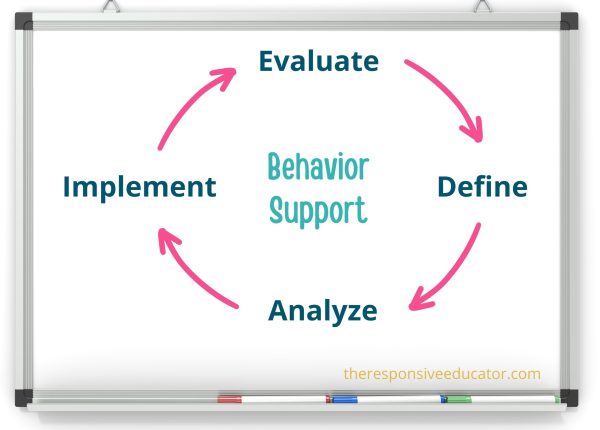
Behavioral baseline data is a crucial tool for understanding student behavior. By collecting baseline data on a student’s behavior, educators can identify patterns, triggers, and antecedents that contribute to problematic behaviors. With this information, educators can create targeted interventions that address the root causes of the behavior, rather than simply addressing the behavior itself.
Additionally, behavioral baseline data can be used as a measuring stick by which to compare progress over time and to evaluate the effectiveness of interventions. By regularly collecting and analyzing data on student behavior, educators can make informed decisions about how to best support each individual student.

Support your students’ individual needs with our exclusive Classroom Concerns Checklist.
Identify key concerns in areas like cognitive skills, communication, social/emotional behavior, and more.
Sign up now to receive instant access and valuable insights on addressing classroom concerns.
Don’t miss out, join our community today!

Support your students’ individual needs with our exclusive Classroom Concerns Checklist.
Identify key concerns in areas like:
…and more to help drive collaboration and problem-solving.
Sign up now to receive instant access and valuable insights on addressing classroom concerns.
